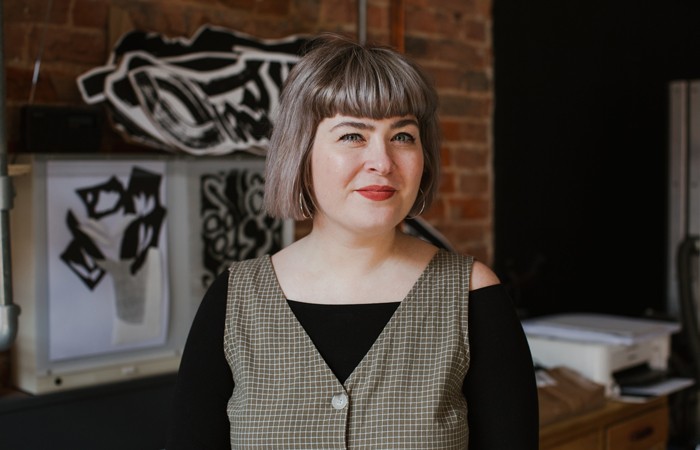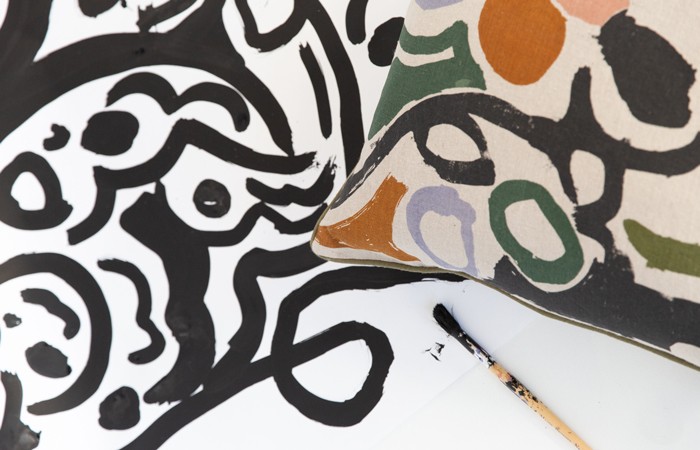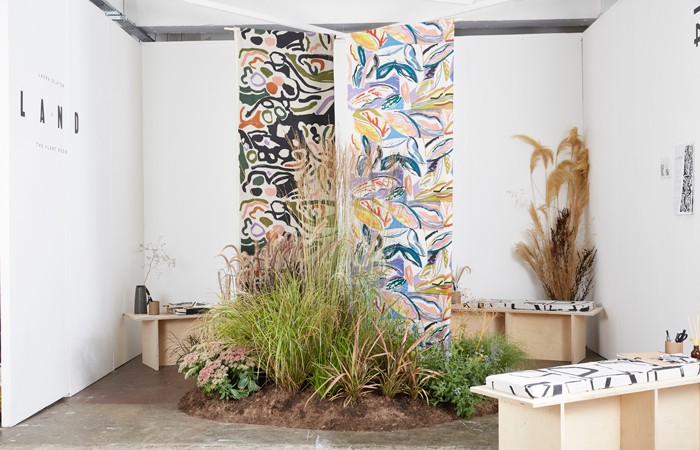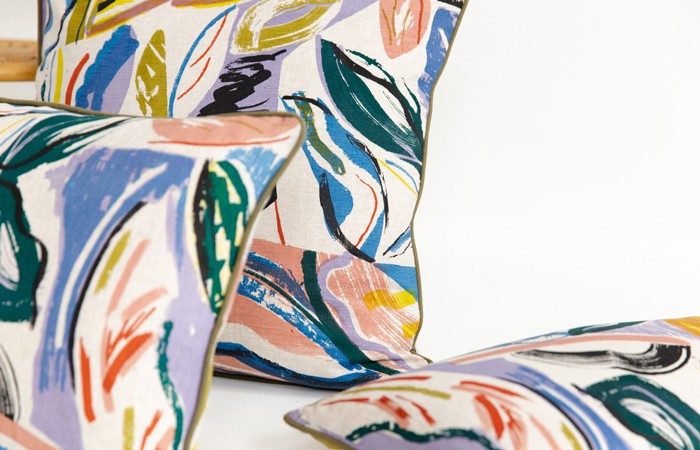Jim Biddulph & Laura Slater in conversation
Whilst we may have lost a large proportion of the manufacturing that made the UK one of the world’s textile super powers during the 18th and 19th centuries, textile design is a still a thriving industry here in the 21st century.
In the north of England, not so far from the historical sites of large-scale textile mills in Lancashire, textile designer Laura Slater plies her trade in a converted industrial mill space in central Leeds.
Having studied BA (Hons) Multimedia Textiles at Loughborough University and Mixed Media Textiles at the Royal College of Art, she set up her business Laura Slater in 2007. Following her studies in London she moved back to her native Yorkshire to set up her first studio. This coincided with being awarded a residency at Huddersfield University, which allowed her to develop her first printed interiors collection and support the development of the brand. Her style is distinct; hand drawn gestural marks are collaged into sumptuously layered formations of pattern and colour.
Her latest space is big, and with good reason. As her business has grown so has the need for space and capacity to work on a larger scale. Working mainly with screen-printing processes, the majority of her textiles are created in house which has led to the accumulation of a lot of equipment, and a need for both design and production spaces. The growth of space has coincided with the generation of projects with some big, household names, with the likes of Heals, John Lewis and Tate coming knocking.
I met with Laura during her preparations for another big project at the Chelsea Flower Show to find out more about her journey and how she likes to work.
JB: Can you give me a bit more insight into how you create a textile collection? Mark making and pattern seem to have always played a key role in your work but where do you start in creating them?
LS: A collection always starts with a concept, it might be thematic, or lead by a specific methodology or process. It always starts by gathering reference points and first hand research. This usually takes the form of a selection of colour, objects and tools to make marks with etc. As my archive of work has grown over the last 10 years I’ve always aimed to be diverse and try new things. I look at a huge range of inspiration, often at painters and artists, and often-specific places inspire my work.
JB: How important is process, and hand processes in particular, in your practice?
LS: Hand process is integral. It is at the core of everything I do, not just in the production of the final product or cloth it’s self but at every stage of the design process. I often try to work as analogue as I can without digital development although sometimes this is unavoidable when time is of the essence! I make hand made marks, through a broad range of process, monoprint, screen-printing mark making, media and materials. Collage is the single most important aspect of my process; even employing this method to make original colour separation’s to put my design work onto screen, or even direct screen printing or collaging on cloth. I can’t imagine working in any other way; I definitely design through the making process.
JB: You also mentioned specific places that help influence your work before, is there anywhere in particular that’s inspired you or helped to form a design?
LS: Yes! I was awarded a 5-week residency in the summer of 2017 at a place called Cove Park, which is located in Argyll and Bute. During the 5 weeks I both lived and worked in a studio on the side of a Loch called Loch Long. The residency was a period of making, research and development and coincided with my 10-year anniversary of graduation from the RCA. The time and focus allowed me to really push my approach through new imagery, colour and mark making. I used the time to employ and explore large scale works using direct printing methods onto cloth, inspired by the surrounding natural landscape. I even tried my hand at outdoor screen-printing. The outcome of the residency was collection called ‘LAND’; a series of three large scale interior pattern based prints that were influenced buy wild foliage and grasses, the Scottish landscape and monolithic like mountains.
JB: Of course! I saw your ‘indoor garden’ style installation at the London Design Fair last year.
LS: That’s right. We launched the ‘LAND’ collection in September 2018 at London Design Festival and create a collaborative installation with Botanical Design Studio The Plant Room to tell the narrative of the collection. We created an indoor prairie style garden in the industrial Truman Brewery for London Design Fair, and invited people to come and join us to take time to sit, rest and make in the installation. The planting scheme echoed the native plants at Cove, the images and colour’s in the print design. One of the outcomes of the show was an invitation from RHS Chelsea Flower Show 2019, for which we have been asked to scale up the installation for an Artisan Garden.
JB: You’ve worked on such a diverse range of projects over your 10-year career. How did the projects with the likes of big brands such as Heals and John Lewis come about? And do they differ to working with a private client?
LS: Working on projects with large retailers has been an amazing development for my practice. It is always an honor to have your work recognized and endorsed by such well thought of brands, and I enjoy the fact that it makes my work accessible to a wider and diverse audience. Many of my projects have come in time with the development of my personal aesthetic and visibility of my work through social media. The projects I have worked upon have been very collaborative experiences, and have been true to my brands approach and design ethos. Some of the main differences in these larger projects are the scale of production, and even placing production and finish in the hands of others, which can be nerve-wracking when you are usually so connected to the development and finishing of the a hand-produced product.
JB: And like me, you’ve also spent some time working at universities and colleges, sharing your design experiences and knowledge with students, as well as a number of galleries.
LS: Yeah, alongside my practice I have always worked in a range of educational roles, from lecturer to creative practitioner in a number of national galleries, including The Hepworth Wakefield, Leeds Art Gallery and Yorkshire Sculpture Park. As a designer my reference points come from a lot of visual artists, painters and printmakers, so galleries feel like home to me. I feel print, pattern and textiles can offer really accessible routes to art for a lot of people; they are part of our everyday. I am interested in how galleries can offer experiences for a diverse range of people to engage with creativity and working with people is a really important aspect of what I do. Realising how important skill and experience sharing is to me, I now also run screen-printing workshops in my own studio space. I think it’s really exciting to offer people the opportunity to spend time in a real working studio and work alongside professional creatives.
Contact Laura Slater








